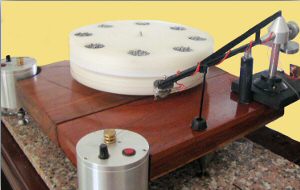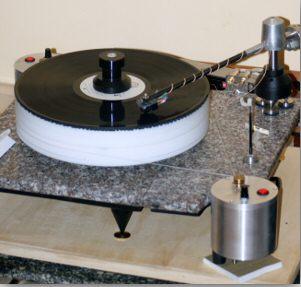Temaad Audio turntable and arm kit 2 – Part II
![[Full kit of parts]](../jpg/temaadio-turntable-kit-of-parts1.jpg)
[ Home | Staff & Contacts | HiFi Playground | Listening tests | DIY & Tweakings | Music & Books ]
![[Full kit of parts]](../jpg/temaadio-turntable-kit-of-parts1.jpg)
Product: Temaad Audio turntable and arm kit 2
Manufacturer: Temaad Audio - China
Cost, approx: approx $500 (US) (YMMV)
Reviewer: Geoff Husband - TNT France
Reviewed: May, 2014
Before I start I have to apologize to readers and the manufacturer for the huge delay in writing part 2 of this turntable review. Inevitably reviews of any Kit take a long time especially something where I wanted to explore possibilities but here the delay became ridiculous as ear infections, digital camera failures, PC suicide and finally – when the review was written - a lightening strike that cooked my hard-drive just added to my usual lassitude in getting things done... I hope the wait is worth it, but the result is that the pictures taken are missing and have been replaced by pictures from the Temaad site – of no great consequence as the designs are self explanatory and as all were built in-the-rough they were hardly pretty or indeed anything that I would want to keep - the alternative of rebuilding them, or showing the debris that remains wasn't attractive...
So excuses over let's get to the nitty-gritty.
The Temaad turntable kit has been described earlier in Part I – what it gives gives you are all the building blocks that go to make a good turntable. A decent platter/motor/bearing assembly and minor things like brass feet. In my case the kit came with the 12" arm complete with cartridge. The latter is unusual as there are not many kit arms on the market and to built it is simply a case of soldering the cartridge tags on and then putting the arm components together – this is easy, in fact beyond the soldering it's no more difficult than assembling any number of 'complete' arms.
The turntable though is another matter. It's very easy to put together in that the maker supplies a template for correct spacing of everything and then you just drill a few holes in a block of wood then put it all together.
And the first incarnation was precisely that – I took a sheet of 18mm MDF (much like the plinth of many budget turntables) and drilled holes for the bearing housing, feet and the arm mount. This is a 'bread-board' test – the most basic of set-ups. I did this for two reasons – the first as a little test for myself; how fast could I build it (it took 2 hours) and the second to give me a quick bench test. If the thing was heavily flawed technically then I was not going to invest considerable time and effort into building more sophisticated designs. Though there are no pictures I hope you can imagine a piece of unpainted MDF with the platter and arm on it and a big hole with the motor dropped through to the support below.
This was the main point of TT One. In this case I used a fishing line drive belt rather than the rubber one first supplied (Ande 8 lb monofilament if you are interested). The result was that with a little adjustment of the motor speed (just a knob on the top of the motor unit) it was possible to get an accurate 33 1/3 with no audible wow or flutter (to my ears). I do have test records for this, but I tend to prefer my ears and my pet test for this is my old copy of Thelonious Monk and Herbie Nichols (Savoy Jazz WL70829) – quite why this old recording (made in 1955 and 1952) should be so pitch critical is beyond me, but the two pianos sound dreadful if a turntable can't do the speed thing.
Actually playing music was easy as the arm is fairly stable for a unipivot and the solid plinth helped. Arm/cartridge resonance was well controlled without damping and the needle swept happily across the record so the first and perhaps most important test of all was passed : with the Temaad Audio the building blocks are technically correct.
So having satisfied myself I wasn't wasting my time I sat and listened.
The first LP on the turntable was of course the aforementioned piano jazz and I was pleased to see that the whole thing timed well – a lack of wow and flutter is not the same as good timing as turntables that don't time well soon demonstrate. Jazz piano, in fact all jazz lives and dies on timing so it's a good test and one most solid plinth designs cope with well.
The top end was fine and there was good detail but all this was obscured by a rather one-note bass and lower mid boom – that flat, undamped board was singing along and as sound level increased it became intrusive.
So the result wasn't really something I could live with and to be honest no better than many budget (real) hi-fi turntables around the kit price. But then that wasn't the point – TT1 was merely a 'proof of concept' – it also made the basic building block for TT2
This was painfully simple. I simply took more MDF and made a shallow box that the TT1 base would fit on. I removed the feet from the original 'board' and now placed them on the bottom of the 'box'. The depth of the box allowed the motor unit to still drop through the hole in the top plate and then rest on the base of the box. The box was now filled with sand. You can do this using a large balloon (just a funnel down the neck – think Foi Gras – or a bin liner, but in my case I was very careful and just used the sand direct into the box. You need to place the motor in the correct position first. Then fill the box level so that the top-plate (the original plinth from TT1) will just drop over with all the rest of the turntable/arm etc ready to go. Now sand and bearings and the like don't mix, but just take care and it'll be OK. The box needs to be fractionally bigger than the top-plate so that the latter can sit on the sand and not touch any of the box sides. Placing the turntable on a level shelf and tapping it with a hammer will sort final leveling of the sand but be patient! If you want to see the inspiration for this then just go back 17 years to the TNT archives!
The result was a nicely conventional looking plinth – though in my case of course it was all plain MDF – total time to build 3 hours.
Given that all that has been added to the TT1 is a box of sand the result is quite amazing. Suddenly the bass tightened up and the deck became far less microphonic. All those resonances disappeared and the combination sounded very good indeed. Quite naturally I began comparing the result to known references many many times the price and this alone made the whole idea of the Temaad turntable make sense.
Now the turntable was producing good levels of clean sound – the bass became tuneful though rather light – and the top end well extended though the sheen of cymbals and the like was a little recessed. The best bit was the midband that was open detailed and had a lovely flow to it – the Morsiani had a similar character but as throughout this test I am extremely reluctant to give any firm opinions on the sound simply because the plinth will have a huge influence (as we've already seen) so what am I hearing? The brilliant nature of the turntable/arm not being screwed up by the plinth or the turntable/arm not screwing up a brilliant plinth design? And as there are an infinite number of variations just in the sand-box – size, depth, type of sand, thickness of wood etc – I am not even going to draw conclusions on which is the best route to go. All I can say at the moment is that the sand-box I built was hugely superior to the simple MDF rectangle of TT1.
Of course that got me thinking – resonance in the plinth was obviously a major problem so what could I do to reduce it? I also wanted to try one totally different idea...
Turntable ThreeThis is simply a cosmetic upgrade to TT1 – instead of the flat MDF I bought an offcut of 40mm thick bamboo kitchen worktop. Otherwise it was identical. The result was a rather attractive turntable compared to the unfinished MDF of TT1 and 2.
I quite liked this – it was really a half-way house compared to the TT1 and 2 – with resonance and microphony somewhere between the two but nearer TT2. In most respects I preferred the cleaner sound of TT2 but what surprised me was the slightly more extended top end – now whether this was because of a different wood, the greater thickness of wood or something the sand damping was taking away I can't say, but building a sand-box using such a top-plate might well be worth-while and again as with TT1, if you begin with the plain plinth and then want to try a sand-based one later it's an easy option to try. The big advantage of TT3 was that it looked pretty attractive and professional from the beginning - a lick of wood oil and careful sanding and it would look just fine in a domestic environment.
Having raided IKEA for the material for TT3 I decided that kitchen worktops might well be the final answer for the next design.
Here I became more ambitious. One reason for building your own turntable is that you can build it big enough to take two arms, this would also help me isolate what contribution the Temaad arm was making by stacking it against a Rega RB300.
For this design I wanted a double plinth so bought two sections of 40mm thick kitchen worktop. They were cut to the same size and the same pasic format as TT1 was used except that the top plate carried the arm and platter, with the motor going through a hole and sitting on the bottom plate. Separating the two were four Foculpods made of Spectra Dynamic's Deflex material with the supplied brass cones underneath. Again this was self-finishing so didn't look bad.
But it sounded dreadful! By far the most resonant and despite the very dense material the slightest touch on the top board would provide a 'Boom! Boom!' through the speakers. It was hopeless, far worse than TT1. So here a very clever idea – to use dense board and isolate the motor as well as giving isolation to the whole top-plate – turned out to be an utter failure. I'd really thought it would work and spent a good 70 Euro on it thinking it would be the final model but it was a waste of time and effort. I should have made an MDF prototype! You've been warned...
Extremely disappointed I found myself looking about for something original – I was also a bit annoyed with myself and so did a major rethink. The problem area appeared to be resonance of the plinth – a thicker plinth or a plinth damped with sand seemed to do the job. So I got ambitious;-) Down the road from us is a stone cutter – making headstones and the like, so I bought a 40 kg slab of polished granite from him (cracked and flawed so cheap... Now I wanted to keep the arm separate from this but still held firm and I was fortunate that I had a stand-alone arm-base made of aluminium filled with lead shot. In any turntable it is the motor that produces the most noise so I wanted that offboard too.
I then took a large 40mm thick hardboard slab I had lying around and simply placed the granite on this. Likewise the stand alone motor and arm-pod in the correct place. I then glued the mainbearing to the granite slab using epoxy resin. Because the machined surface of the block was totally flat this worked really well – the alternative of drilling and bolting to the granite didn't seem attractive for many reasons (not least that I wanted to dismantle and reuse the granite (pastry board in fact...). The arm 'pod' was adjustable so aligning everything took little time and so what sounds exotic actually only took a day to get together.
Hmmm. After all that hype I'd expected something special. In some respects it was – the noise floor was way down, it all sounded very tight and rhythmic, but somehow the whole thing sounded a bit pushy or edgy for my taste. It could sound exciting to start with, and the imaging was that of a serious turntable, but it just got tiring to listen to after a while. I know some people like this sort of thing so the test wasn't a write off and the thing looked amazing, but in all honesty it just tried too hard for my taste.
Below you'll see a few (very poor) pictures from the Teemadaudio site - they seem to have almost as much trouble with pictures as I do...



Tricky...
What all the above shows is that the review of a turntable kit - where the whole design of the plinth is left to the builder - can never be more than a basic guide. The Temaad kit worked – technically it was fine – the components good enough to produce a quality turntable and the arm in particular being extremely interesting – quality 12" arms are not normally this accessible and it's performance certainly didn't let the side down. I'm on record (sic) in having a soft spot for 12" arms and this one seemed a good example of the breed.
For me this has been something of a learning experience – I expected the double plinth to be good – it wasn't. I expected the granite plinth with offboard arm-pod to be brilliant – it wasn't. In fact the order of excellence from worse to best was clearly – TT 4, TT1, TT5, TT3, TT2.
If I were to be building the turntable for my own use then I would be happy to start off with the simple thick bread-board of TT3 – easy to make (the easiest configuration of all) self finishing, good looking and already superior to turntables like the Rega Planar series with which it will inevitably be compared. But then to build a sand-box as with TT2, but rather than MDF, to use heavy Bamboo worktop would produce a turntable than might be even better than TT2 but again would be essentially self-finishing and look rather imposing. That would be my next test, but being considerably out of pocket and taking several weeks there has to be a limit to my experimentation (and it's not a process I'll do again!) - the point is that you could try an infinite variety of plinths and supports and get a different result with each. I'd never fully appreciated how nice it is for someone else to have done all this work (not construction, but development) when I buy a complete turntable! With the Temaad there is always the temptation to 'try something else' to get the last bit of fidelity from it. Regular readers will see that I've not made my usual more detailed analysis of every aspect of the performance and that is simply because the turntable you end up with will not sound like any of the above. It may be subtly different (what grain size sand will you use? How dense is your work-top etc) or totally different. To say that you will produce a turntable that will better than an Orbe, or sound like a Roksan is just pushing the imagination too much.
In its best configuration i.e. the 'sandbox' I did get to see some of the potential of the kit. The arm reminded me strongly of the Morsiani and that is very high praise (though as always – different TT, different cart etc), but the turntable proved a very clean solid performer – it has good pace and timing, the bass is even, the treble extended and the imaging very good left-right. Now if I criticize the Temaad because the stage image is rather shallow I'm talking rubbish because with a subtly, or completely different plinth the turntable might image like a Rockport – you get the point I hope... As it it is I got the kit to the stage where it would happily compete with anything I've tried up to say the 1000 Euro class. As such, with a simple build it represents very good value, but be aware that you may NEVER be satisfied and a life of hi-fi torment and tweeking may ensue – if this attracts you then go for it – if it will drive you nuts then avoid like the plague;-)
And lastly one thing to remember with all kits is that their resale value is minimal. Just as home built speakers, the second-hand value is likely to be less than the kit new and so you have to write off all material costs and time. If you are happy to do this, and generally people who build things tend to keep them for themselves then fine...
© Copyright 2014 Geoff Husband - geoff@tnt-audio.com - www.tnt-audio.com
[ Home | Staff & Contacts | HiFi Playground | Listening tests | DIY & Tweakings | Music & Books ]